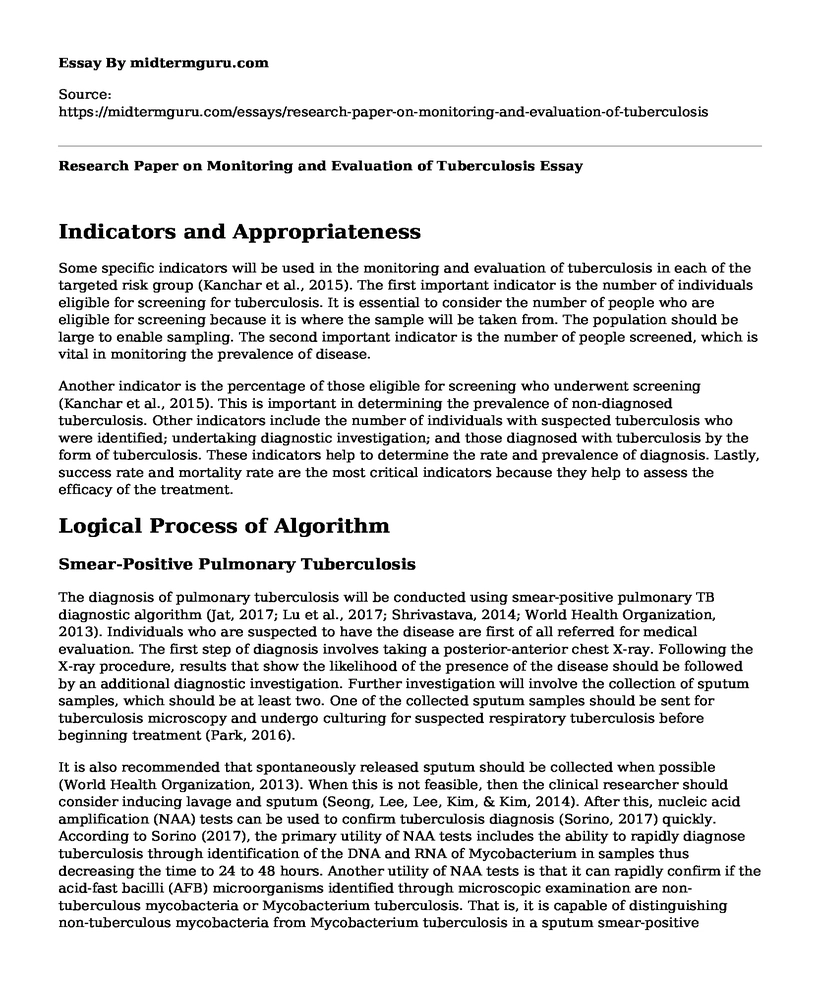Indicators and Appropriateness
Some specific indicators will be used in the monitoring and evaluation of tuberculosis in each of the targeted risk group (Kanchar et al., 2015). The first important indicator is the number of individuals eligible for screening for tuberculosis. It is essential to consider the number of people who are eligible for screening because it is where the sample will be taken from. The population should be large to enable sampling. The second important indicator is the number of people screened, which is vital in monitoring the prevalence of disease.
Another indicator is the percentage of those eligible for screening who underwent screening (Kanchar et al., 2015). This is important in determining the prevalence of non-diagnosed tuberculosis. Other indicators include the number of individuals with suspected tuberculosis who were identified; undertaking diagnostic investigation; and those diagnosed with tuberculosis by the form of tuberculosis. These indicators help to determine the rate and prevalence of diagnosis. Lastly, success rate and mortality rate are the most critical indicators because they help to assess the efficacy of the treatment.
Logical Process of Algorithm
Smear-Positive Pulmonary Tuberculosis
The diagnosis of pulmonary tuberculosis will be conducted using smear-positive pulmonary TB diagnostic algorithm (Jat, 2017; Lu et al., 2017; Shrivastava, 2014; World Health Organization, 2013). Individuals who are suspected to have the disease are first of all referred for medical evaluation. The first step of diagnosis involves taking a posterior-anterior chest X-ray. Following the X-ray procedure, results that show the likelihood of the presence of the disease should be followed by an additional diagnostic investigation. Further investigation will involve the collection of sputum samples, which should be at least two. One of the collected sputum samples should be sent for tuberculosis microscopy and undergo culturing for suspected respiratory tuberculosis before beginning treatment (Park, 2016).
It is also recommended that spontaneously released sputum should be collected when possible (World Health Organization, 2013). When this is not feasible, then the clinical researcher should consider inducing lavage and sputum (Seong, Lee, Lee, Kim, & Kim, 2014). After this, nucleic acid amplification (NAA) tests can be used to confirm tuberculosis diagnosis (Sorino, 2017) quickly. According to Sorino (2017), the primary utility of NAA tests includes the ability to rapidly diagnose tuberculosis through identification of the DNA and RNA of Mycobacterium in samples thus decreasing the time to 24 to 48 hours. Another utility of NAA tests is that it can rapidly confirm if the acid-fast bacilli (AFB) microorganisms identified through microscopic examination are non-tuberculous mycobacteria or Mycobacterium tuberculosis. That is, it is capable of distinguishing non-tuberculous mycobacteria from Mycobacterium tuberculosis in a sputum smear-positive individual (Ryu, 2015).
If positive results for results for AFB smear tests as well as NAA are obtained, then it indicates that the patient has tuberculosis and that anti-tuberculosis treatment should be started while waiting for culture results (Pagana, Pagana, & Pike-MacDonald, 2018). The higher positive predictive value of Food and Drug Association approved NAA tests for tuberculosis is >95% in AFB smear-positive cases (Ryu, 2015).
Other Salient Features of the Algorithm
Other salient features of the algorithm are the capacity to determine the survival rates and death rates. Both of these indicators are important in different ways. First, survival rates are essential in assessing the efficacy of the treatment regimen. On the other hand, death rates help in monitoring whether the severity of the disease.
Strengths and Limitations of the Algorithm
The primary strength of the algorithm is the use of robust methods for the diagnosis of tuberculosis. This will ensure that only individuals who have tuberculosis will form part of the collected data. Conversely, the limitation of the algorithm is the long process of diagnosis and follow-up on participants' life. This may make the algorithm too expensive.
References
Jat, K. R. (Ed.). (2017). Case based reviews in pediatric pulmonology (First Edition). New Delhi: Jaypee, The Health Sciences Publisher.
Kanchar, A., Getahun, H., Joint United Nations Programme on HIV/AIDS, United States, President's Emergency Plan for AIDS Relief, WHO Global TB Programme, ... Global Fund to Fight AIDS. (2015). A Guide to monitoring and evaluation for collaborative TB/HIV activities. Retrieved from https://extranet.who.int/iris/restricted/bitstream/10665/150627/1/9789241508278_eng.pdf
Lu, Y., Wang, L., Duanmu, H., Chanyasulkit, C., Strong, A. J., & Zhang, H. (2017). Handbook of global tuberculosis control: practices and challenges. Springer.
Pagana, K. D., Pagana, T. J., & Pike-MacDonald, S. A. (2018). Mosby's Canadian manual of diagnostic and laboratory tests - e-book. Retrieved from https://nls.ldls.org.uk/welcome.html?ark:/81055/vdc_100059630064.0x000001
Park, J. S. (2016). Issues related to the updated 2014 Korean guidelines for tuberculosis. Tuberculosis and Respiratory Diseases, 79(1), 1-4. https://doi.org/10.4046/trd.2016.79.1.1
Ryu, Y. J. (2015). Diagnosis of pulmonary tuberculosis: recent advances and diagnostic algorithms. Tuberculosis and Respiratory Diseases, 78(2), 64-71. https://doi.org/10.4046/trd.2015.78.2.64
Seong, G. M., Lee, J., Lee, J. H., Kim, J. H., & Kim, M. (2014). Usefulness of sputum induction with hypertonic saline in a real clinical practice for bacteriological yields of active pulmonary tuberculosis. Tuberculosis and Respiratory Diseases, 76(4), 163-168. https://doi.org/10.4046/trd.2014.76.4.163
Shrivastava, S. (2014). Tuberculosis control: an Indian perspective. SM Online Publishers LLC.
Sorino, C. (2017). Diagnostic evaluation of the respiratory system. The Health Sciences Publisher.
World Health Organization (Ed.). (2013). Systematic screening for active tuberculosis: principles and recommendations. Geneva, Switzerland: World Health Organization.
Cite this page
Research Paper on Monitoring and Evaluation of Tuberculosis. (2022, Nov 03). Retrieved from https://midtermguru.com/essays/research-paper-on-monitoring-and-evaluation-of-tuberculosis
If you are the original author of this essay and no longer wish to have it published on the midtermguru.com website, please click below to request its removal:
- Essay on Pros and Cons of Abortion
- Increasing Patient Safety and Quality of Care - Essay Example
- Paper Example on Psychological Benefits of Touch Bond after Birth
- Paper Example on Immunization
- Heroin: A Brief History of Its Use and Addictiveness - Essay Sample
- Bob Selling Unapproved Drugs to US Consumers: Potential Harms - Essay Sample
- Fight Against Drugs - Research Paper







